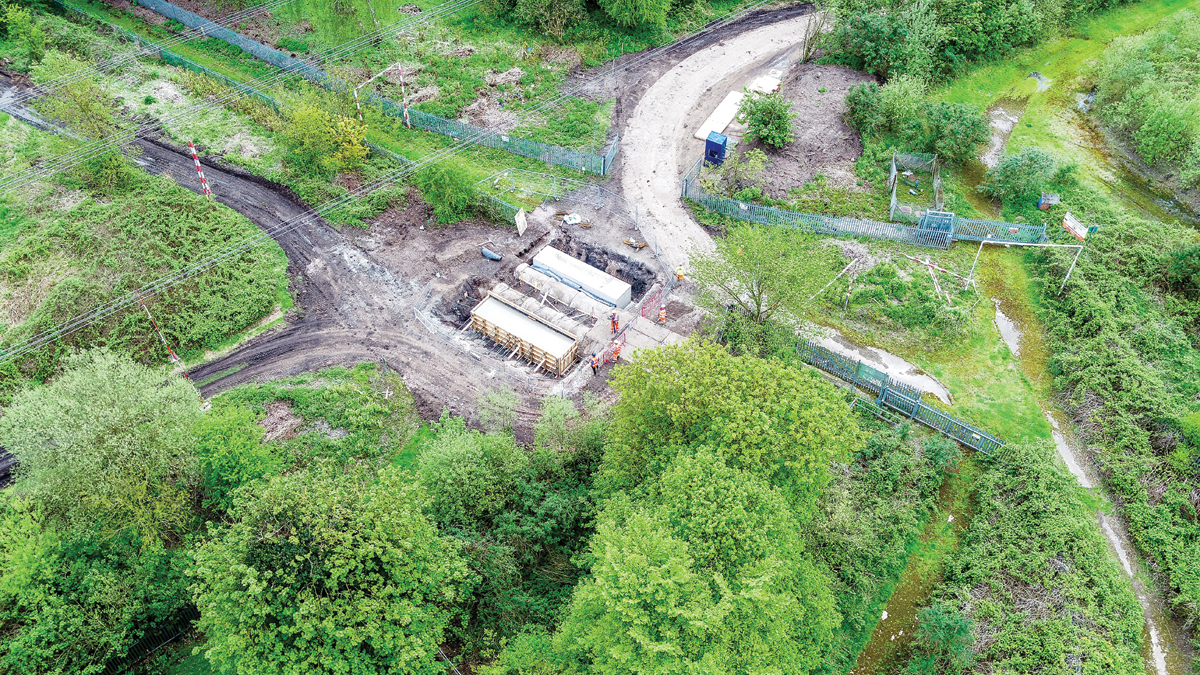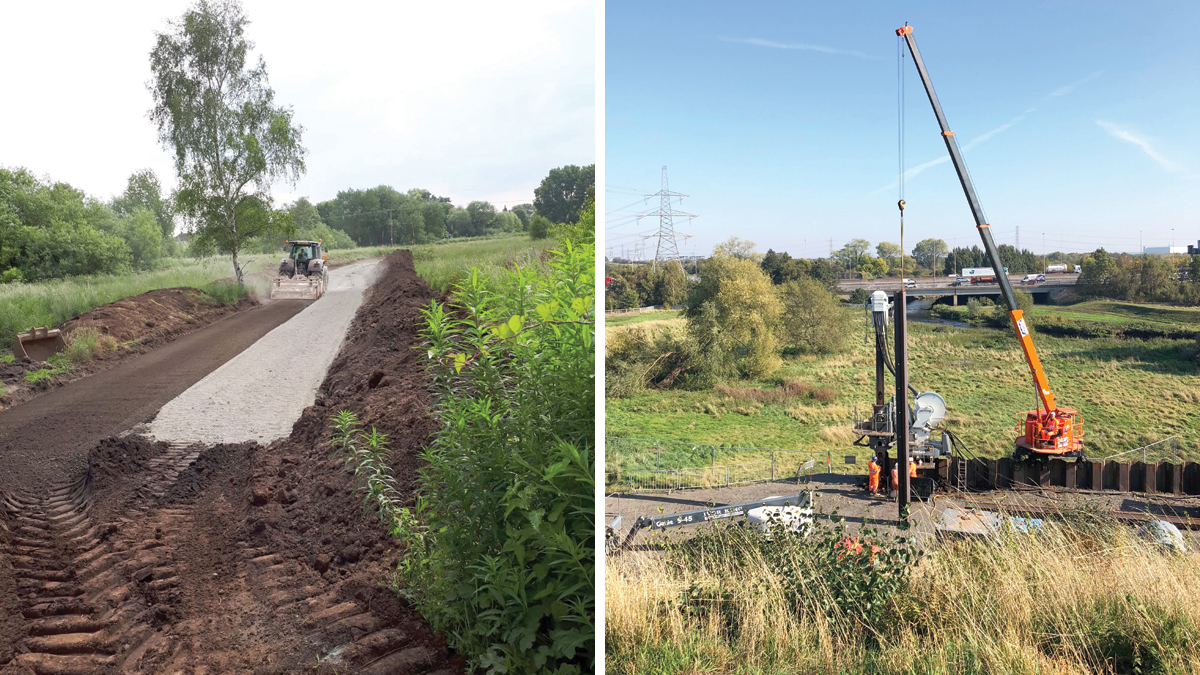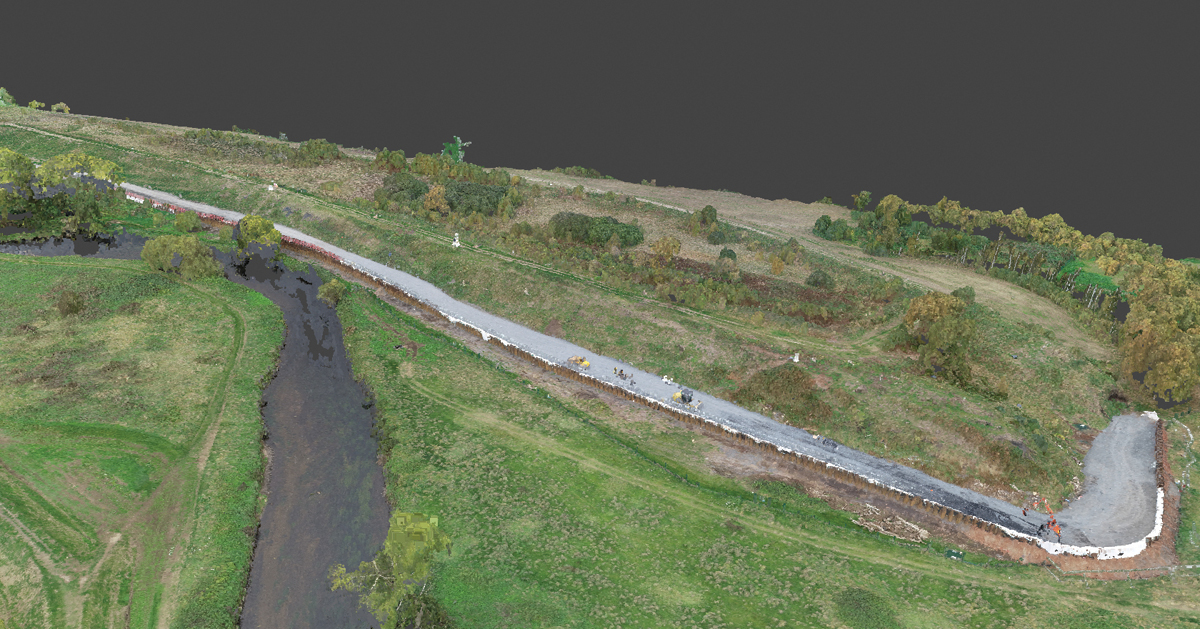Minworth STW – Curdworth Sludge Lagoons (2019)

Aerial view of bridge construction - Courtesy of Severn Trent
The Curdworth Sludge Lagoon is located within Severn Trent’s Minworth STW site, alongside the Minworth Final Effluent Channel situated to the north and the River Tame to the south. It was constructed during the early 1900s. Filling operations ceased during the late 1940s and it has remained in its current state since that time. The structure comprises non-engineered embankments, formed using dried sludge and imported industrial waste materials. The stored volume of sludge waste material is approximately 1,100,000m3, at depths of up to 8m so the lagoons are a registered asset under the provisions of the Reservoirs Act 1975.
Inspections and assessments of the Curdworth Sludge Lagoon concluded that improvements were required to maintain the integrity of the structure. Measures were required to reduce the risk of embankment deterioration and failure by improving the stability of the lagoon embankments. Protection against the risk of erosion, due to fluvial flooding, along the vulnerable sections of the south embankment, adjacent to the River Tame was also a requirement. The Local Resilience Forum has been appraised of progress during the development and implementation of the proposals, which have delivered a significant reduction in risk.
Risk assessment
In 2014, MWH UK (now Stantec UK) was commissioned to undertake detailed feasibility works. A quantitative risk assessment was carried out which identified high, medium and low risk sections along the lagoon embankments. This demonstrated that the factor of safety against failure along some sections was marginal. A 444m length of the south embankment, that posed the greatest risk owing to its probability of slope failure, low factor of safety and proximity to the River Tame, was prioritised for the first phase of improvement works. The options and solutions identified and appraised included the use of mass concrete, gabion baskets, bored piling, sheet piling, soil stabilisation and geotextile membranes, targeting a minimum factor of safety on slope stability of 1.3.
Options appraisal
Physical site constraints were significant factors in the appraisal and viability of solutions as well as overall cost. This section of the lagoon embankment is situated within the flood plain of the River Tame where flood compensation works would be required when existing provisions were altered or reduced by embankment re-profiling and placement of imported materials. There was also the risk of flooding of the works and potential for embankment erosion during construction. Poor road access for heavy plant, restricted working areas and the impact of vibration from construction plant on the adjacent fragile lagoon embankments were also key considerations.
Reinforcement using traditional sheet piling and rock filled gabion baskets were identified as the most favourable solutions, though concerns about the effects of vibration on the lagoon embankments from traditional piling works resulted in a preference for a gabion wall solution, at the toe of the embankment.
Adopted solution
Severn Trent appointed Costain and its design partner Stantec to develop an embankment reinforcement solution. Costain evaluated the preferred solution in detail and concluded that the provision of a gabion wall would also present an uncomfortable level of risk, during construction. The need to remove significant volumes of material at the toe of the embankment would have a temporary impact on slope stability, particularly in the event of a river flood condition occurrence.
Working collaboratively with Severn Trent and specialist sub-contractor Ivor King The Piling People, the team developed an alternative solution adopting Giken Supercrush technology. This employs a silent piling rig which would press interlocking steel sheet piles into position, using a vibration-free method of installation.

(left) Haul road stabilisation and (right) sheet piling using Giken Supercrush piling – Courtesy of Severn Trent
Contract award
The contract to undertake the design and construction works, valued at around £6.5m, was awarded to Costain, in August 2017, with completion planned in February 2019. Detailed design was undertaken by Costain’s design partner Stantec UK and implementation was overseen by an All Reservoirs Panel Engineer supported by a specialist team engaged through Mott MacDonald.
Enabling works
Vehicular access on to the Curdworth Lagoon site was through the Minworth STW operational site. It was restricted, at the site entrance, by a public right of way passing alongside the access gate as well as shallow, twin, 1500mm diameter, final effluent discharge pipes. Site access tracks around the lagoon were un-surfaced, compacted soils, suitable only for light four-wheel drive vehicles. There were also strategic overhead power lines and pylons crossing the entrance and passing along the northern side as well as strategic water and gas mains crossing the south side of the site.
The safe movement of construction plant and pedestrian traffic crossing the site entrance was managed with the use of manual, temporary lockable gates and full-time gate staff, throughout the construction period. Critical final effluent discharge pipes were protected using a substantial in situ, reinforced concrete slab. A prefabricated steel bridge from Mabey Hire was erected on deep, reinforced concrete abutments, facilitating the safe passage of heavy construction plant over the pipes, throughout the works. The bridge was retained as a permanent asset, on completion.
A new haul road and associated crane platforms, providing access for piling works construction plant and site traffic, were formed using a cement based, ground stabilisation technique. Following vegetation clearance and ground preparation, material was mixed into a 300mm layer of the soil surface, rolled, compacted and cured to form a strong durable foundation. This was then protected by the addition of a compacted 75mm thick layer type 1 road stone along the running surface. This solution minimised the excavation and disposal of materials from the site, as well as avoiding the need to import significant volumes of road stone, traditionally required to form a comparable haul road. The haul road was created in around 6 weeks and this method produced significant cost savings.
Design
The design comprised the provision of a 444m long interlocking sheet piled wall positioned between the toe of the southern lagoon embankment and the bank of the River Tame. Imported granular fill material rolled and compacted behind the sheet piles, would provide additional weight at the toe and improved embankment slopes.
Sections of the re-profiled lagoon embankments extended into the River Tame flood plain, in some areas, resulting in the partial loss of existing flood compensation provisions. River modelling works were carried out as part of the design process in order to identify suitable alternative flood compensation areas, within the confines of the Curdworth Lagoon site.
Minimisation of vibration and safeguarding against potential embankment movement were vital considerations, which led to the incorporation of a comprehensive installation of vibration monitoring stations and movement monitoring instruments, for use during the construction works.

Aerial view of Curdworth Lagoon – Courtesy of Severn Trent
Supply chain: Key participants
- Client: Severn Trent
- Main contractor: Costain
- Specialist support: Mott MacDonald
- Designers: Stantec UK
- Curdworth Embankment silent piling: Ivor King The Piling People
- Piling equipment: Giken Supercrush Technology
- Prefabricated steel bridge: Mabey Hire Ltd
Construction
A complex monitoring system to measure vibration and monitor potential embankment movement was installed at the outset, prior to the commencement of construction works. This was to ensure that embankment stability was monitored and maintained at all times. The suite of instrumentation comprised 76 (No.) surface mounted survey prisms across the embankment surveyed by two solar powered automatic total stations, 8 (No.) inclinometers up to 18m deep within the body of the embankment, and 9 (No.) real time surface mounted vibration sensors. Instrumentation trigger levels were set at a very high level of sensitivity. Real time data was available for review and analysis on line and automatic alerts were transmitted to key project personnel by email and text messaging, throughout the construction works.
Construction of the sheet piled wall commenced early in July 2018, using a Giken Supercrush silent piling rig from Ivor King The Piling People. This adopts a vibration-free process, which progressively presses piles into position. Following initial set-up, the system utilises adjacent installed piles to support the piling rig and provide a reaction to the downward force required to press the next pile into position.
This eliminates the requirement for the provision of extensive piling platforms, as work progresses to construct the sheet piled wall. The plant also incorporates a small mechanical auger that can be used to remove stiff material, in advance of pressing each pile into position.
Curdworth Lagoon Embankment Stabilisation – Courtesy of Ivor King – The Piling People
This can be used to maintain a smooth and accurate installation process. The operation was also supported by a telescopic clamp crane that progresses along the top of the installed pile wall to take up its position for driving the next pile. The completed wall comprises around 750 steel sheet piles, 7 to 11m in length, embedded into the underlying Mercia Mudstone.
Backfilling behind the piled wall with imported material was executed progressively, as the sheet piles were advanced, facilitating prompt demobilisation and removal of construction plant, when the wall was complete. The work was carried out within a narrow working corridor, bounded by the River Tame and the toe of the Curdworth Lagoon Embankment.
Completion
The project was comfortably completed on time and no embankment instability events occurred during construction.





